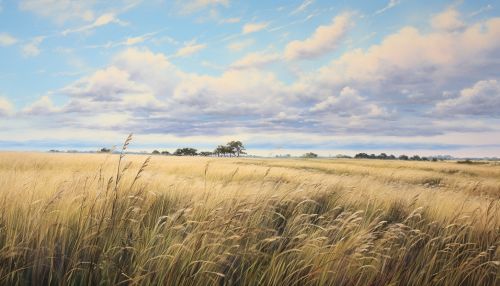Wind
Introduction
Wind is a natural phenomenon characterized by the movement of air from high pressure areas to low pressure areas. It is a crucial component of the atmosphere, playing a significant role in the weather patterns and climate of our planet.


Formation and Characteristics
Wind forms due to differences in atmospheric pressure. When there is a high pressure area adjacent to a low pressure area, the air will naturally flow from the high pressure area to the low pressure area, creating wind. This process is driven by the sun's heat, which warms the Earth unevenly, resulting in variations in air pressure.
The speed and direction of the wind are influenced by several factors, including the pressure gradient, the Coriolis effect, and friction with the Earth's surface. The pressure gradient refers to the rate at which atmospheric pressure changes over a certain distance. The Coriolis effect, caused by the Earth's rotation, causes moving air to be deflected to the right in the Northern Hemisphere and to the left in the Southern Hemisphere. Friction with the Earth's surface slows down the wind and changes its direction.
Types of Wind
There are several types of wind, each with unique characteristics and effects.
Local Winds
Local winds are small scale winds produced by locally generated pressure gradients. They include sea breezes, land breezes, mountain breezes, and valley breezes.
A sea breeze is a wind that blows from the sea towards the land. It is caused by the differential heating of land and sea, with the land heating up faster than the sea during the day, creating a low pressure area over the land. The cooler, denser air over the sea then moves towards the land, forming a sea breeze.
A land breeze is the opposite of a sea breeze. It occurs at night when the land cools faster than the sea, creating a high pressure area over the land. The cooler, denser air over the land then moves towards the sea, forming a land breeze.
Mountain and valley breezes are caused by the differential heating of mountain slopes and valleys. During the day, the mountain slopes heat up faster than the valleys, creating a low pressure area on the slopes. This causes a valley breeze, with air moving up the slopes from the valley. At night, the process is reversed, with the slopes cooling faster than the valleys, creating a mountain breeze, with air moving down the slopes into the valley.
Planetary Winds
Planetary winds are large scale winds that blow in a consistent pattern over large areas of the Earth. They include the trade winds, the westerlies, and the polar easterlies.
Trade winds are steady winds that blow from east to west in the tropics. They are caused by the Earth's rotation and the differential heating of the Earth's surface, which creates a low pressure area near the equator.
The westerlies are winds that blow from west to east in the middle latitudes. They are caused by the rotation of the Earth and the differential heating of the Earth's surface, which creates a high pressure area near the poles and a low pressure area near the equator.
The polar easterlies are winds that blow from east to west in the polar regions. They are caused by the rotation of the Earth and the differential heating of the Earth's surface, which creates a high pressure area over the poles.
Measurement and Observation
Wind is measured using an instrument called an anemometer, which measures wind speed, and a weather vane, which measures wind direction. Wind speed is usually reported in kilometers per hour (km/h) or meters per second (m/s), while wind direction is reported as the direction from which the wind is coming.
Observation of wind patterns is crucial for weather forecasting. Meteorologists use a variety of tools and techniques to observe and predict wind patterns, including weather balloons, weather satellites, and numerical weather prediction models.
Impact on Human Activities
Wind has a significant impact on a variety of human activities.
Agriculture
In agriculture, wind can both benefit and harm crops. On the positive side, wind can help pollinate plants by carrying pollen from one plant to another. However, strong winds can also damage crops by breaking plant stems, uprooting plants, and causing soil erosion.
Energy Production
Wind is a valuable source of renewable energy. Wind turbines convert the kinetic energy of the wind into mechanical energy, which can then be converted into electricity. Wind energy is a clean, sustainable alternative to fossil fuels, and its use is growing rapidly around the world.
Transportation
Wind has played a crucial role in transportation throughout history. For centuries, wind powered sailing ships were the primary means of long-distance travel and trade. Today, wind still plays a role in sailing, and wind conditions are also a critical consideration in aviation.
